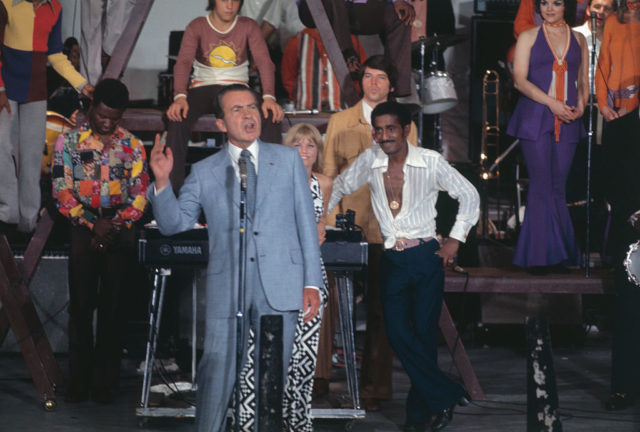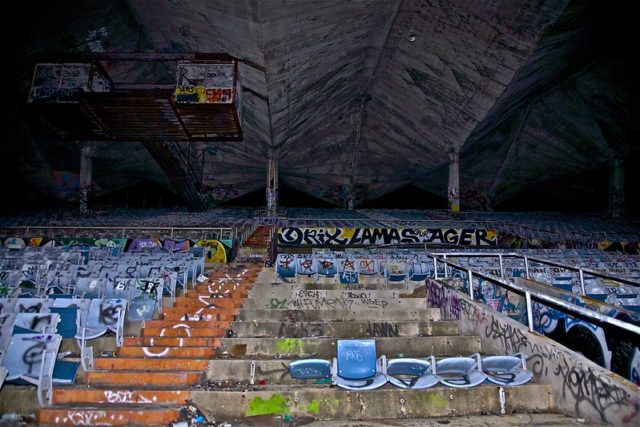The Miami Marine Stadium was the world’s first and only stadium built to watch boat races. Despite one racer dying on the opening day of the park, the stadium was a booming business for years – until it was left demolished by Hurricane Andrew in 1992. The old stadium now sits abandoned on Virginia Key in Miami, where it has been ravaged by vandals and the natural elements.
The height of water sports

The Miami Marine Stadium was designed in 1962 by 28-year-old Cuban-born architect, Hilario Candela. The idea for the stadium came at a time when the popularity of water sports was exploding throughout the United States.

The city of Miami was looking for a stadium that would be finished quickly and wouldn’t cost too much money. Candela felt that the stadium needed to be constructed with concrete to help protect it from the salt air and water. The stadium was built for around $2 million and was completed in 1963.

The stadium opened on December 27, 1963, and was dedicated as the Ralph Munroe Marine Stadium. Ralph Munroe was an American yacht designer and an early resident of Coconut Grove in South Florida. The stadium could hold over 6,000 people.
Major events occurred here

On the stadium’s opening day, one of the speed boat racers, James Tapp, was killed during a race. His death might have been a bad omen for what was in store for the stadium. Nonetheless, for the next two decades, people enjoyed water sporting events and concerts at the unique venue.

The stadium utilized a loading stage in front of the grandstand to host world-class powerboat events. It hosted a variety of powerboat races as well as a number of different televised events, including the Bill Muncey Invitational and the ESPN All-American Challenge Series.

In its later years, the stadium also hosted boxing matches, concerts, and even Easter Sunday services. The stadium was prominently featured during Elvis Presley’s speedboat race scene in his 1967 film, Clambake. The venue was also the site of the famous hug between President Nixon and Sammy Davis Jr. during a rally for Nixon’s presidential re-election in 1972.

By the 1980s, the stadium started seeing a decline in events. Newer venues were popping up throughout Miami, taking away potential performers. The last major race at the stadium was the 20th Annual Budweiser Hydroplane Regatta at the start of June of 1990.
A compromised structure thanks to Hurricane Andrew

In 1992, Hurricane Andrew ripped through the Bahamas, Florida, and Louisiana. This category five hurricane was the most destructive storm to ever hit Florida in terms of the structures damaged or destroyed. The Miami Marine Stadium was one of the many structures impacted by Hurricane Andrew. After the storm, Miami city engineers condemned the stadium due to cracks found in its foundation.

The stadium was more or less completely abandoned until 2008 when the Friends of Miami Marine Stadium was founded. The purpose of this group is “the restoration and return to operation of Miami Marine Stadium. It is the goal of the Friends of Miami Marine Stadium to work with the City and community at large to accomplish this purpose and have it operated in the public interest.” Gloria Estefan’s charity group is a major contributor to the Friends of Miami Marine Stadium.

In 2013, the City of Miami granted the Friends of Miami Marine Stadium control of the property. In 2014, the group returned with a revitalization proposal and supposed funds. Their proposal would have cost about $121 million, but ultimately was shot down by the City Commission. The city once again has resumed control of the stadium and restoration has been put on hold.

More from us: Rubber Bowl – University of Akron Football Stadium
Events still occasionally take place at the Miami Marine Stadium, In February 2016, the stadium hosted the Miami Boat Show, and in 2019, it hosted the Miami International Boat Show and the USA Swimming Open Water National Championships. At the end of November 2021, a tribute was held there for Louis Vuitton’s artistic director, Virgil Abloh.
The continued use of the stadium makes fans and supporters hopeful that it will once again be a bustling venue one day.
